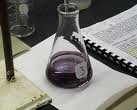Iodometry and Iodimetry
Titrations based on oxidation and reduction reactions are called redox reactions. These chemical reactions proceed with the transfer of electrons amongst the reacting ions in aqueous solutions.
The reduction of free iodine to iodide ions and oxidation of iodide ions to free iodine occur in iodometric and iodimetric titrations.
In iodimetric titrations, free iodine is used. Since it is difficult to prepare the solution of iodine (iodine sublimates and is less soluble in water) it is dissolved in KI solution.
KI+I2 ---> KI3
This solution is first standardized before use. With the standard solution of I2 , substances such as sulfite, thiosulphate, arsenite are estimated.
In iodometric titrations, an oxidizing agent is allowed to react in neutral medium or in acidic medium with excess of KI to liberate free iodine.
KI +oxidizing agent ----> I2
Free iodine is titrated against a standard reducing agent usually with sodium thiiosulfate. Halogens, oxyhalogens, cupric ions, peroxides etc can be estimated by this method.
I2+Na2S2O3---> 2NaI +Na 2S2O4
2CuSO4 + 4KI ---> Cu2I2 + 2K2SO4+I2
K2Cr2O7 + 6KI + 7H2SO4 ---> Cr2(SO4)3 + 4K2 SO4 + 7H2O +3I2
In both iodometric and iodimetric titrations, starch is used as an indicator. Starch solution gives a blue or violet color with free iodine. At the end point the blue or violet color disappears when iodine is completely changed to iodide.
Iodometric (oxidation of iodide) titrations comprise of two steps –
In the first step oxidizing agents such as KMnO4, K2Cr2O7 , CuSO4 , peroxides etc are treated with an excess of KI when iodine is liberated quickly and quantitatively. For eg.
2MnO4- +16 H+ +10 I----> 2Mn 2+ + 5I2 + 8H2O
Cr2O7 2- +14 H+ +6I- ---> 2Cr3+ +3I2 +7H2O
2Cu2+ + 4I- ----> Cu2I2+ I2
In the second step-
The liberated iodine is titrated against a standard solution of sodium thiosulfate using starch as an indicator. All such titrations in which iodine is liberated from potassium iodide with the help of an oxidizing reagent and is titrated against a standard solution of sodium thiosulfate are called iodometric titrations.
Reactions with iodide
MnO4 -
2MnO4-+ 10I -+ 16H+---> Mn2+ +5I2 + 8H2O
Cr2O7 2-
Cr2O7 2- +6I -+14H+ ----> 2Cr3+ +I2 + 7H2O
IO3-
IO3- + 5I- +6H+ ---> 3I 2 + 3H2O
BrO3 -
BrO3 + 6I- +6H+----> Br-+3I2 + 3H2O
Cr4+
2Cr4+ + 2I- ---> 2Cr3+ + I2
Fe3+
2Fe3+ + 2I- ----> 2Fe2+ + I2
H2O2
H2O2 + 2I- +2H+ ---> 2H2O + I2
As (V)
H3AsO4 + 2I- +2H+ ---> H3AsO3 +I2 + H2O
Cu2+
2Cu 2+ + 2I- ----> 2Cu I + I2
HNO2
2 HNO2 + 2I- ---> I2 + 2NO + H2O
SeO32-
SiO32- + 4I- ----> 2CuI + I2
O3
O3 + 2I- + 2H+ ---> O2 + H2 + H2O
Cl2
Cl2 + 2I- ---> 2 Cl- + I2
Br2
Br2+ 2I- ----> 2Br- +I2
HClO
HClO+2 I-+ 2H+----> Cl- + I2 + H2O
Iodimetric Titrations
In an Iodimetric titrations (reduction of iodine) the direct use of iodine as an oxidizing agent in neutral or slightly acidic medium using starch as an indicator is made. The various reducing agents used in these titrations are thiosulfates, sulfites, arsenites or antimonites.
I2+ S2O32----> 2I- +S4O62-
thiosulfate tetra thionate
I2+SO32- + H2O ----> 2I- + SO42- + 2H+
sulfite sulfate
I2+ AsO32-+ H2O - ----> 2I-+ AsO42- + 2H+
arsenite Arsenate
I2 + SbO33- + H2O ----> 2I-+ SbO42- + 2H+
Antimonite Antimonite
H2S+I2--> S + 2I- +2H+
Sn2+ + I2---> Sn4+ + 2I-
N2H4 + 2I2---> N2 + 4H+ + 4I-
A mixture of K2Cr2O7 and KMnO4 was treated with excess of KI in an acidic medium. The iodine liberated required 100 cm3 of 0.15 N sodium thiosulfate solution for titration. The % amount of each can now be determined.
The redox changes that occur in the reaction mixture are -
5e + Mn7+ ---> Mn2+ (reduction)
6e+ Cr 26+ ---> 2Cr3+ (reduction)
2I 1- ---> I2 +2e (oxidation)
2S2O3 ----> S4 O62- + 2e (oxidation)
We can now calculate the amount of dichromate and permanganate.
Let the amount of dichromate and permanganate be a and b gms
a+b = 0.5 g Equation 1
milli eq of dichromate + milli eq of permanganate = milli eq of Iodine = milli eq of sodium thiosulfate
a/294/6 X 1000 + b/ 158/5 X1000 = 100 X 0.15 Equation 2
From eqns 1 and 2
a= 0.073 and b= 0.427
Therefore % of dichromate is 14.6% and % of permanganate is 85.4%





